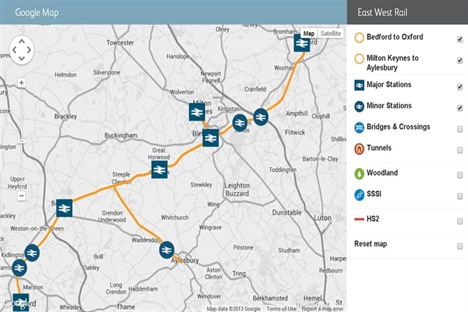12.12.13
Oxford-Cambridge Varsity Line reopening proposals gather steam
The Varsity Line between Oxford and Cambridge could be reopened after nearly 50 years, as the government looks to extend the East West Rail link, the western section of which is already funded and approved.
The line was closed due to a lack of use as the rolling stock used at the time ran too slowly. But the government is starting work on the proposal, which would see the construction of a new railway line linking Bedford and Cambridge, and a new interchange station.
DfT spokesman Jon Rhodes told the Oxford Mail: “The department is working closely with local authorities to identify a potential route for the Bedford to Cambridge railway line, which would allow trains to run direct between Oxford and Cambridge and potentially to other destinations further east.
“This work should be completed by the spring after which we will consider how it could be financed.”
The ‘western section’ of East West Rail already has approval and funding. It will re-introduce passenger and freight services between Bedford and Oxford, Milton Keynes and Aylesbury (see map below). It involves upgrading and reconstructing sections of existing and mothballed rail track, and is to be delivered by Network Rail. Surveying work has already begun.
The difficult ‘central section’ of East West Rail is Bedford-Cambridge, including the link between Bedford and Sandy, where some land has already been redeveloped since the line closed in the 1960s. Many bridges have been removed or are in a poor state, and the Bedford bypass severs the line.
The ‘eastern section’ of East West Rail covers freight and passenger services between Cambridge and East Anglia.
Caryl Jones, spokeswoman for the East West Rail Consortium, said: “By connecting centres of economic activity and growth, East West Rail will make the region more attractive as a place to do business, for employers and employees and for inward investment.
“It is expected to boost the regional GDP by some £38m per annum and create 12,000 new jobs.”

The proposed new passenger services on the western section of East West Rail are reproduced below:
Reading to Bedford via Oxford
Complementing the new Chiltern Railways Oxford to London Marylebone service via Bicester (due 2016), an hourly service is proposed, calling at Didcot Parkway, Oxford, Oxford Parkway, Bicester Town, a new station at Winslow, Bletchley, and onward to Bedford Midland via Woburn Sands and Ridgmont.
Bletchley to Bedford
The existing hourly service stopping at all stations between Bletchley and Bedford will continue to operate, complementing the faster service described above.
Reading to Milton Keynes via Oxford
Taking the same route as the Bedford service to Bletchley, and then onward to Milton Keynes Central, where new Platform 2a has already been constructed in anticipation of East West Rail train services. This is also envisaged to be an hourly service that effectively provides an orbital link between the Great Western Main Line at Reading across to the West Coast Main Line at Milton Keynes.
Together with the Reading to Bedford service, this will provide a half-hourly service between Reading, Didcot Parkway, Oxford, Bicester Town and Bletchley.
Milton Keynes to London Marylebone via Aylesbury and High Wycombe
Services are expected to run hourly calling at Bletchley, the new station at Winslow, Aylesbury Vale Parkway, Aylesbury, Princes Risborough, High Wycombe and onward to London Marylebone.
Overall journey time is expected to be between 88-91 minutes. The particular significance of this route is that it provides Buckinghamshire residents with a train service to Milton Keynes, the fastest growing city in England with its many employment, shopping and leisure opportunities as well as access to the West Coast Main Line services at Milton Keynes Central and making Aylesbury in particular more accessible by public transport.
Tell us what you think – have your say below, or email us directly at [email protected]